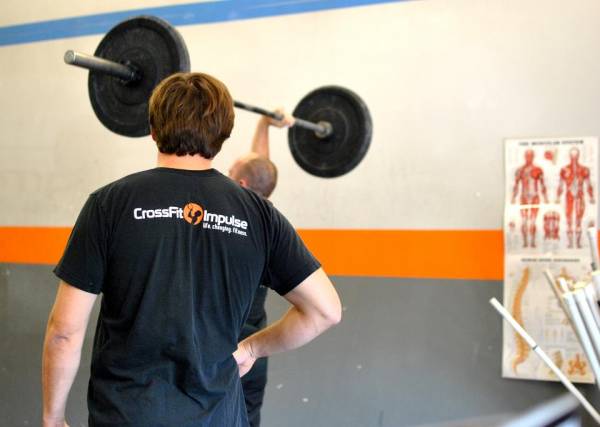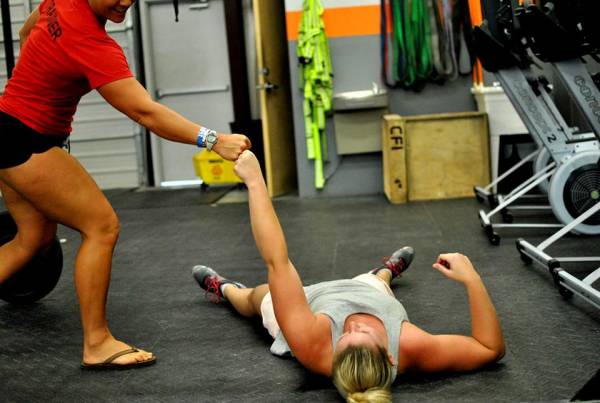As the CrossFit Open approaches, more CrossFit trainers will be taking the CrossFit judges course to become certified judges. Even though the course gives you a basic blueprint, nothing can outweigh actual experience. My first year judging was not an easy one, and I was lucky to have a mentor by my side to show me the ins and outs of judging and how to make the correct calls. I’m going to share some of what I learned, and hopefully these tips will help you make the best decisions too. Because as a judge, you can have the power to send elite athletes to regionals or keep them at home.
Judging Tip #1: Always View the Standard Videos
Usually the night before an open workout, there will be a standards video released. These videos are valuable to judges and athletes alike. The video will outline what you need to know as a judge and give you visual reference as to what a no-rep will look like. Don’t just look at these videos, pay attention to them in their entirety. You may find information you did not know regarding what constitutes good reps and what makes a bad rep. For example, last year, at the bottom of the toes-to-bar movement the athlete’s heels had to pass behind the plane of the bar, which was a bit new for me. Many athletes had a hard time getting their heels behind the bar, which made for some no reps. Had I not watched the video, I would have not known to no rep these toes-to-bar attempts.
Judging Tip #2: Anatomy Is Important! Every BODY Is Different
It’s important for judges to understand that all bodies are different. Lockouts, squat depth, and other movements are going to look different on everyone. Some people (like myself) have elbows that hyperextend, while other people don’t. Some people have the same issue with their knees or hips. Other people may not have this issue, or have flexibility problems instead. So one athlete’s squat depth can be deeper than another, while both are below parallel.
Probably the most problematic area in this regard is any movement that requires the lockout overhead. Many people have difficulty seeing whether or not an athlete has achieved lockout of the elbows due to the athlete’s anatomy. In my opinion, the best place to look is around the elbow joint area. You will see certain muscles contract when the athlete is in full lockout (like the triceps). These are things judges must pay attention to. If you are having difficulty figuring out what an overhead lockout looks like on an athlete, my advice is to watch them warm up. Usually when athletes warm up at lighter weight you will be able to see what a full lockout is for that athlete, and then you will be able to judge them accordingly.
Judging Tip #3: Visual Is Everything – Know Where to Stand
 One of the most important aspects of judging is knowing exactly where to stand so you can get the best visual of the movement (and stay out of the athlete’s way). This sort of practice and information is valuable. It will make it easier on you and the athlete. One example I can give is, again, toes-to-bar. During last year’s CrossFit Games Open, it was required that the toes make physical contact with the bar. So for me, this was a bit hard to see (I’m short!). To remedy this I would stand next to the athlete on top of a box with my hand on the bar itself (way off to the side, where I would not be in the way). Doing this, I could physically feel the vibration of the contact the toes made with the bar, which made it easier for me to count reps (or not). These little tricks will make your life easier and make for fair judging.
One of the most important aspects of judging is knowing exactly where to stand so you can get the best visual of the movement (and stay out of the athlete’s way). This sort of practice and information is valuable. It will make it easier on you and the athlete. One example I can give is, again, toes-to-bar. During last year’s CrossFit Games Open, it was required that the toes make physical contact with the bar. So for me, this was a bit hard to see (I’m short!). To remedy this I would stand next to the athlete on top of a box with my hand on the bar itself (way off to the side, where I would not be in the way). Doing this, I could physically feel the vibration of the contact the toes made with the bar, which made it easier for me to count reps (or not). These little tricks will make your life easier and make for fair judging.
Judging Tip #4: How to Judge the Pesky Butterfly Kips
You will find that when it comes to elite athlete, butterfly kips are usually easy to judge. But when it comes to athletes new to butterfly kips, judging can be quite difficult. Usually people think their chins are over the bar, but in many cases it’s not true. Even when elite athletes begin to fatigue, their butterfly kip can turn into no-reps. For you as a judge, the best place to stand is right next to the athlete, facing the side of them, so you are able to see if the chin is reaching over the bar. Usually people are moving pretty quickly when doing butterfly kips, so it’s important to signal the athlete immediately when you see a no-rep.
Judging Tip #5: Gather Advice from More Advanced Judges
In my first year of judging, I had a lot of help from a friend who had judged several other events before I even thought about becoming a judge (she was also a regional-level judge). Her advice was valuable to me because when it came to areas where I was weak or did not know what to do, she was always there to answer a question. No judge is perfect, especially if you are new to it. So do not be afraid to ask a question when needed. You want to make sure you judge accurately and correctly, and a seasoned judge can help you do that. Veteran judges can also teach you tricks that will both make your life easier and make your judging more accurate.
Judging Tip #6: Don’t Judge Your Friends
 It can be very difficult to remain impartial when judging a friend. You want what is best for them, and of course you want your friend to go to the regional level and maybe the final games. In this scenario, you are more apt to let some no-reps slide for the sake of your friend. It’s better to judge someone you either don’t know at all or someone you don’t know well. You are able to remain impartial and judge fairly based off what the athlete is doing. Now that certain elite level athlete’s videos have to be submitted, it will be painfully obvious if this person is your friend and you let bad reps get by. If you judge your friend and are not impartial to them, understand you may let a slot for a better athlete be taken up, which is not fair to anyone. In addition, for your friend’s sake, it’s better for you not to judge them so no one can even question their score and performance based on your involvement.
It can be very difficult to remain impartial when judging a friend. You want what is best for them, and of course you want your friend to go to the regional level and maybe the final games. In this scenario, you are more apt to let some no-reps slide for the sake of your friend. It’s better to judge someone you either don’t know at all or someone you don’t know well. You are able to remain impartial and judge fairly based off what the athlete is doing. Now that certain elite level athlete’s videos have to be submitted, it will be painfully obvious if this person is your friend and you let bad reps get by. If you judge your friend and are not impartial to them, understand you may let a slot for a better athlete be taken up, which is not fair to anyone. In addition, for your friend’s sake, it’s better for you not to judge them so no one can even question their score and performance based on your involvement.
Judging Tip #7: Do Not Be Afraid to No-Rep Someone
Giving a no-rep is not fun at all, but sometimes it has to be done. When athletes fatigue, most of the time their form begins to fall by the wayside. If you see the standards are being broken, do not be afraid to tell the athlete a rep doesn’t count. You’re not going to be anybody’s best friend being a judge, and you may get ugly looks for giving no reps, but let’s be honest – you are a judge and this is what you signed up for. As a judge in the CrossFit Games Open, you are the first line to who gets to regional level or not. So if you get an ugly face because of a no rep, it is okay. You know you have only everyone’s best interest in mind.
Judging is important at all levels of the CrossFit Games in that the judges hold the line of qualification for athletes hoping to advance. Now that many of the athletes have to submit videos, not only are the athletes being looked at – but so are their judges. If you decide to judge, make sure you are fair no matter the situation. Be smart about how you make decisions. And don’t be afraid to ask questions of more experienced judges, because that is how you learn. I hope these tips will help you during the open if you are a judge, and perhaps beyond. Things are competitive and everyone wants a fair shot at going to regionals and the games.
What are your experiences of judging in CrossFit events, either as a judge or an athlete? Do you have tips to share? Post to the comments below.
Photos courtesy of CrossFit Impulse.






